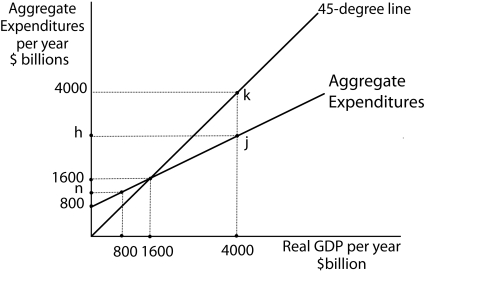Correct Answer

verified
Correct Answer
verified
Multiple Choice
Consider a simple aggregate expenditure model where all components of aggregate expenditure are autonomous except consumption.If government purchases increases by $200 billion, the aggregate expenditures curve will shift up by
A) $200 billion.
B) $200 billion * the multiplier.
C) $200 billion * marginal propensity to consume.
D) $200 billion * (1 ÷ marginal propensity to consume) .
Correct Answer

verified
Correct Answer
verified
Multiple Choice
Use the following to answer questions
Exhibit: Real GDP and the Multiplier
 -(Exhibit: Real GDP and the Multiplier)
What is the value of the multiplier?
-(Exhibit: Real GDP and the Multiplier)
What is the value of the multiplier?
A) 2.5
B) 3
C) 5
D) 15
Correct Answer

verified
Correct Answer
verified
Multiple Choice
Consider a simple aggregate expenditure model where all components of aggregate expenditure are autonomous except consumption.The marginal propensity to consume is 0.8.Suppose the equilibrium level of real GDP at the prevailing price is $500 billion below potential real GDP.All else constant, by how much should autonomous aggregate expenditures be increased to reach potential output?
A) $625 billion
B) $500 billion
C) $400 billion
D) $100 billion
Correct Answer

verified
Correct Answer
verified
Multiple Choice
Expenditures that do not vary with the level of real GDP are called
A) exogenous aggregate expenditures.
B) induced aggregate expenditures.
C) endogenous aggregate expenditures.
D) autonomous aggregate expenditures.
Correct Answer

verified
Correct Answer
verified
True/False
If consumption is given by C = $10 billion + 0.5Y, and autonomous planned investment, government purchases, and net exports amount to $5 billion, then aggregate expenditures are $20 billion if Y = $10 billion.
Correct Answer

verified
Correct Answer
verified
Multiple Choice
Disposable personal income is
A) the income households receive after paying personal taxes and personal debt.
B) the income households earn from supplying labor services for the production of aggregate output.
C) the income households receive after paying personal taxes.
D) the income households have leftover after paying personal taxes and purchasing necessities.
Correct Answer

verified
Correct Answer
verified
Multiple Choice
Use the following to answer questions
Exhibit: Aggregate Expenditures Curve
Figure 13-6  -(Exhibit: Aggregate Expenditures Curve)
Suppose the government purchases economy rise by $100.What is the new equilibrium level of real GDP?
-(Exhibit: Aggregate Expenditures Curve)
Suppose the government purchases economy rise by $100.What is the new equilibrium level of real GDP?
A) $1,700
B) $1,800
C) $1,900
D) $2,100
Correct Answer

verified
Correct Answer
verified
Multiple Choice
Use the following to answer questions
Exhibit: Consumption and Real GDP  -(Exhibit: Consumption and Real GDP)
The marginal propensity to consume equals
-(Exhibit: Consumption and Real GDP)
The marginal propensity to consume equals
A) 0.
B) 0.5.
C) 1.0.
D) 2.0.
Correct Answer

verified
Correct Answer
verified
Multiple Choice
Use the following to answer questions
Exhibit: Aggregate Expenditures (AE)
in a Simplified Economy
 -(Exhibit: Aggregate Expenditures (AE)
In a Simplified Economy)
Let Y = real GDP, AE = Aggregate Expenditures, C = Consumption, IP = Planned Investment.Consider a simple economy that is made up of only two sectors, households and firms, and that all investment is autonomous.Further, disposable personal income = real GDP.Suppose autonomous investment rises by $50 billion.In the short run, this will cause
-(Exhibit: Aggregate Expenditures (AE)
In a Simplified Economy)
Let Y = real GDP, AE = Aggregate Expenditures, C = Consumption, IP = Planned Investment.Consider a simple economy that is made up of only two sectors, households and firms, and that all investment is autonomous.Further, disposable personal income = real GDP.Suppose autonomous investment rises by $50 billion.In the short run, this will cause
A) an increase in equilibrium AE of $100 billion, a shift to the right of the aggregate demand (AD) curve of $100 billion, and an increase in Y of more than $100 billion.
B) an increase in autonomous AE of $50 billion, a shift to the right of the AD curve of $100 billion, and an increase in Y of less than $100 billion.
C) an increase in autonomous AE of $50 billion, a shift to the right of the AD curve of $100 billion, and an increase in Y of more than $200 billion.
D) an increase in equilibrium AE of $50 billion, a shift to the right of the AD curve of $300 billion, and an increase in Y of less than $300 billion.
Correct Answer

verified
Correct Answer
verified
Multiple Choice
If an economy is in equilibrium,
A) planned investment equals zero.
B) unplanned investment equals zero.
C) there is no change in inventories.
D) inventories equals zero.
Correct Answer

verified
Correct Answer
verified
Multiple Choice
Use the following to answer questions
Exhibit: Real GDP and the Multiplier
 -(Exhibit: Real GDP and the Multiplier)
If government purchases increase by $100 billion, the aggregate expenditures curve will shift up by $_______ billion.
-(Exhibit: Real GDP and the Multiplier)
If government purchases increase by $100 billion, the aggregate expenditures curve will shift up by $_______ billion.
A) 100
B) 250
C) 400
D) 500
Correct Answer

verified
Correct Answer
verified
Multiple Choice
Use the following to answer questions
Exhibit: Consumption and Real GDP  -According to the permanent income hypothesis,
-According to the permanent income hypothesis,
A) a change in income regarded as permanent will have a greater impact on saving than on consumption.
B) a change in income regarded as temporary will have a greater impact on saving than on consumption.
C) regardless of whether a change in disposable personal income is permanent or temporary; people will change consumption by moving along the consumption function.
D) a change in income regarded as temporary will not affect consumption much since it will have little effect on average lifetime income.
Correct Answer

verified
Correct Answer
verified
Multiple Choice
Let AE = Aggregate Expenditures, C = Consumption, IP = Planned Investment, G = Government Purchases.Consider a simple aggregate expenditures model, where AE = C + IP + G and all components of aggregate expenditures except consumption are autonomous.In this model, the multiplier is _____.
A) 1 ÷ (1 -MPS) where MPS = marginal propensity to save
B) 1 ÷ MPC where MPC = marginal propensity to consume
C) 1 ÷ MPS where MPS = marginal propensity to save
D) MPC ÷ MPS ÷ ∆Y
Correct Answer

verified
Correct Answer
verified
Multiple Choice
Use the following to answer questions
Exhibit: Aggregate Expenditures Curve
Figure 13-6  -(Exhibit: Aggregate Expenditures Curve)
Let Y = real GDP, AE = Aggregate Expenditures, C = Consumption, IP = Planned Investment, G = Government Purchases.Further, IP and G are autonomous.If real GDP produced is $4,000, how will equilibrium be restored in the economy?
-(Exhibit: Aggregate Expenditures Curve)
Let Y = real GDP, AE = Aggregate Expenditures, C = Consumption, IP = Planned Investment, G = Government Purchases.Further, IP and G are autonomous.If real GDP produced is $4,000, how will equilibrium be restored in the economy?
A) Policymakers must conduct contractionary policies to move the economy toward its equilibrium real GDP.
B) Firms will reduce their output in subsequent periods, moving the economy toward its equilibrium real GDP.
C) The price level must rise to reduce aggregate expenditures and restore equilibrium.
D) The price level must fall to increase aggregate expenditures and restore equilibrium.
Correct Answer

verified
Correct Answer
verified
True/False
The current income theory assumes that current consumption is based on the average income people expect to receive for the remainder of their lives.
Correct Answer

verified
Correct Answer
verified
Multiple Choice
In the simple aggregate expenditure model where all components of aggregate expenditure are autonomous except consumption, what is the value of the multiplier if the slope of the aggregate expenditures curve is 0.8?
A) 1
B) 4
C) 5
D) Cannot be determined without information on marginal propensity to consume.
Correct Answer

verified
Correct Answer
verified
Multiple Choice
Use the following to answer questions
Exhibit: Consumption and Real GDP  -The average annual income that people expect to receive for the remainder of their lives is called
-The average annual income that people expect to receive for the remainder of their lives is called
A) lifetime income.
B) permanent income.
C) disposable personal income.
D) current income.
Correct Answer

verified
Correct Answer
verified
True/False
A change in autonomous aggregate expenditures will shift aggregate demand by an amount equal to the change in autonomous aggregate expenditures times the multiplier.
Correct Answer

verified
Correct Answer
verified
Multiple Choice
Use the following to answer questions
Exhibit: Income and Consumption
 -The amount of consumption that would take place if real GDP were zero is called
-The amount of consumption that would take place if real GDP were zero is called
A) induced consumption.
B) exogenous consumption.
C) autonomous consumption.
D) break even consumption.
Correct Answer

verified
Correct Answer
verified
Showing 181 - 200 of 214
Related Exams